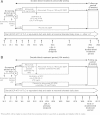Efficacy and safety of alirocumab, a fully human PCSK9 monoclonal antibody, in high cardiovascular risk patients with poorly controlled hypercholesterolemia on maximally tolerated doses of statins: rationale and design of the ODYSSEY COMBO I and II trials
- PMID: 25240705
- PMCID: PMC4190302
- DOI: 10.1186/1471-2261-14-121
Efficacy and safety of alirocumab, a fully human PCSK9 monoclonal antibody, in high cardiovascular risk patients with poorly controlled hypercholesterolemia on maximally tolerated doses of statins: rationale and design of the ODYSSEY COMBO I and II trials
Abstract
Background: Alirocumab is a fully human monoclonal antibody to proprotein convertase subtilisin kexin type 9 (PCSK9) under investigation for treatment of hypercholesterolemia and reduction of cardiovascular events.
Methods/design: The COMBO studies, part of the Phase 3 ODYSSEY clinical trial program, are designed to evaluate the efficacy and safety of alirocumab as add-on therapy to stable, maximally tolerated daily statin, with or without other lipid-lowering therapy (LLT), in a planned 966 patients with hypercholesterolemia at high cardiovascular risk. COMBO I ( http://clinicaltrials.gov/show/NCT01644175) is placebo-controlled, with a double-blind treatment period of 52 weeks, and 306 planned patients who may receive other LLTs in addition to statin therapy. COMBO II ( http://clinicaltrials.gov/show/NCT01644188) has a double-blind treatment period of 104 weeks, comparing alirocumab with ezetimibe in 660 planned patients receiving statin therapy (but no other LLTs). The primary efficacy endpoint is the difference between treatment arms in percent change in low-density lipoprotein cholesterol (LDL-C) from baseline to week 24. Both studies utilized a starting dose of alirocumab 75 mg every 2 weeks (Q2W; administered as 1 mL solution via auto-injector). Patients with LDL-C levels ≥70 mg/dL after 8 weeks of treatment were up-titrated in a blinded manner at week 12 to alirocumab 150 mg Q2W (also 1 mL auto-injector).
Discussion: In conclusion, the COMBO studies will provide information on the long-term efficacy and safety of alirocumab in high-risk patients when administered in addition to maximally tolerated statin therapy, with a flexible dosing strategy which allows for individualized therapy based on the degree of LDL-C lowering needed to achieve the desired treatment response.
Trial registrations combo i: NCT01644175 ( NCT01644175).
Combo ii: NCT01644188 ( NCT01644188).
Figures

References
-
- Mihaylova B, Emberson J, Blackwell L, Keech A, Simes J, Barnes EH, Voysey M, Gray A, Collins R, Baigent C. The effects of lowering LDL cholesterol with statin therapy in people at low risk of vascular disease: meta-analysis of individual data from 27 randomised trials. Lancet. 2012;380:581–590. doi: 10.1016/S0140-6736(12)62027-3. - DOI - PMC - PubMed
-
- Baigent C, Blackwell L, Emberson J, Holland LE, Reith C, Bhala N, Peto R, Barnes EH, Keech A, Simes J, Collins R. Efficacy and safety of more intensive lowering of LDL cholesterol: a meta-analysis of data from 170,000 participants in 26 randomised trials. Lancet. 2010;376:1670–1681. doi: 10.1016/S0140-6736(10)61350-5. - DOI - PMC - PubMed
-
- Perk J, De Backer G, Gohlke H, Graham I, Reiner Z, Verschuren M, Albus C, Benlian P, Boysen G, Cifkova R, Deaton C, Ebrahim S, Fisher M, Germano G, Hobbs R, Hoes A, Karadeniz S, Mezzani A, Prescott E, Ryden L, Scherer M, Syvänne M, op Scholte op Reimer WJ, Vrints C, Wood D, Zamorano JL, Zannad F. European Guidelines on cardiovascular disease prevention in clinical practice (version 2012). The Fifth Joint Task Force of the European Society of Cardiology and Other Societies on Cardiovascular Disease Prevention in Clinical Practice (constituted by representatives of nine societies and by invited experts) Eur Heart J. 2012;2012(33):1635–1701. - PubMed
-
- Reiner Z, Catapano AL, De Backer G, Graham I, Taskinen MR, Wiklund O, Agewall S, Alegria E, Chapman MJ, Durrington P, Erdine S, Halcox J, Hobbs R, Kjekshus J, Filardi PP, Riccardi G, Storey RF, Wood D. ESC/EAS Guidelines for the management of dyslipidaemias: the Task Force for the management of dyslipidaemias of the European Society of Cardiology (ESC) and the European Atherosclerosis Society (EAS) Eur Heart J. 2011;32:1769–1818. doi: 10.1093/eurheartj/ehr158. - DOI - PubMed
-
- Anderson TJ, Gregoire J, Hegele RA, Couture P, Mancini GB, McPherson R, Francis GA, Poirier P, Lau DC, Grover S, Genest J, Jr, Carpentier AC, Dufour R, Gupta M, Ward R, Leiter LA, Lonn E, Ng DS, Pearson GJ, Yates GM, Stone JA, Ur E. 2012 update of the Canadian Cardiovascular Society guidelines for the diagnosis and treatment of dyslipidemia for the prevention of cardiovascular disease in the adult. Can J Cardiol. 2013;29:151–167. doi: 10.1016/j.cjca.2012.11.032. - DOI - PubMed
Pre-publication history
-
- The pre-publication history for this paper can be accessed here:http://www.biomedcentral.com/1471-2261/14/121/prepub
Publication types
MeSH terms
Substances
Associated data
LinkOut - more resources
Full Text Sources
Other Literature Sources
Medical
Miscellaneous

